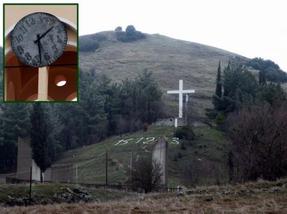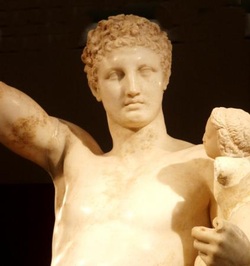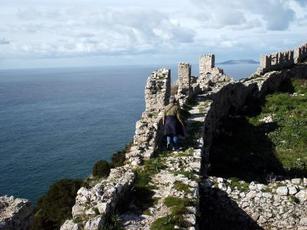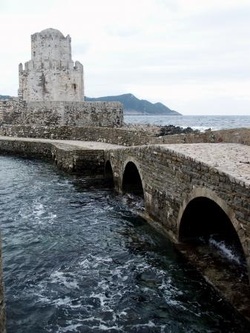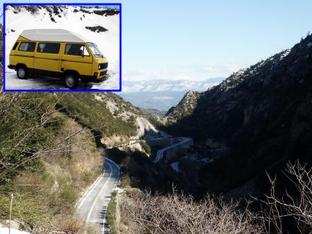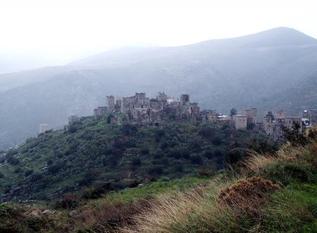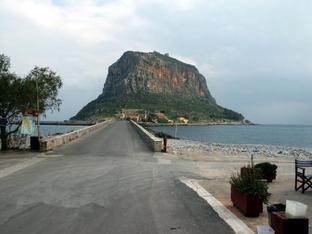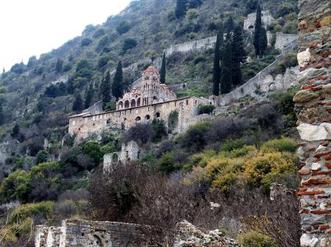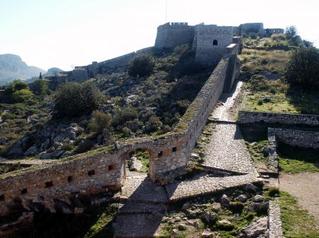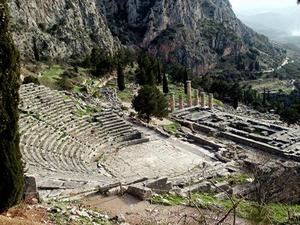
Fortunately the wind had somewhat died down and rain had stopped by the time we started packing up on Thursday. Our trip started out by crossing the new suspension bridge from Rio to Antirio, and then heading east following the shore of the Gulf of Corinth. We would continue about 100 km (60 miles) to Itea, grab a left, climb the side of the mountain for about another 20 km and there we were….Ancient Delphi and Sanctuary of Apollo. (A little side note: yesterday (Friday) we picked up a “English” newspaper, and they had an article on the bridge…It was closed right after we crossed, because of “HIGH WINDS AND RAIN lightening had struck one of the suspension cables and tore it, it will be closed for a few days” it only opened Dec 04’. This is one of the prettiest bridges we have ever seen. One thing I will never forget about it is the toll…15 EUROS ($20+) one way !!!!…a little …(HELL, A LOT) hefty for a toll…) . Because of the late arrival time (1:30pm) and rain at Delphi, we decided to just take in the Archeological Museum today and tomorrow (Friday), we’ll get an early start at the ancient site and head out again in the afternoon. For the Greeks, Delphi was “The Navel of the Earth”. During the 1600 BC period, the Mycenaean’s built this for the goddess Gaea, but by the end of the Mycenaean period, Apollo had replaced all other god’s. Delphi reached it’s height in the 4th century BC, when multitudes of pilgrims came to ask advice of its “oracle” who was believed to speak for Apollo. The oracle had influence over all things, from personal to wars….want to get married ???, see the oracle to see if this is the right time, person, will the first born be a son ??? We walked the Sanctuary of Apollo, Roman agora, the Sacred Way, visited the Temple of Apollo, the theatre, and to the top of the site to see the stadium, which is the best preserved in Greece. While we were there, there was a group of students that took to running from the start line in the stadium to the end…no one made it to the end… We also met a family from Montana while we were there. They were traveling from Athens to Delphi by bus, and having a good time in Greece. After about 2 hours covering the site, we decided to head back to “Bumble Bee” and hit the road again. Our journey today will take us back towards Antirio and then north, up the Ionian Sea to Igoumenitsa. This was about a 5 hour journey, and our first intensions were to find a campground and stay over. Well the best laid plans are made only to possibly be changed…we were able to catch a ferry to Bari, Italy, which would leave at 7pm and we could “camp” (in Bumble Bee) right on the deck of the boat. So, for 120 Euros, we were all set and ready to ship out.
Our night on the boat turned out to be just OK… Everything with Bumble Bee was great, but, sometime in the night, we got into a thunder and lightning storm and the waves picked up…what a ride…not much sleep after that, and we had to be ready for a 6 am departure from the ship as well. The nuts of that was, the ship didn’t dock until just about 9, so we really missed our sleep. Louise and I had given some thought to what route we would take after leaving the boat, so we headed up the coast towards Foggia. During this drive up the coast, we got talking about what options we had for campgrounds that might be open to us in the winter. If we continued up the eastern coastline, we didn’t have much to chose from, but if we went over to the western coastline, we had quite a number available. So, take a left turn, and head off to Napoli (Naples). Then we had a stunning surprise start before us….SNOW !!! Like all snow storms, it started out with just a flake once in awhile, and then…I’m glad they were Johnny on the spot with the sanding and plowing…we needed all the help we could get. We had snow for just about ¾ of the way across the country, and then when we finally arrived in Napoli, we had left the snow behind and just had the cold and wet of the same storm. We found our campsite in Pompeii, and are just across the street from Ancient Pompeii which we will see later on our return trip. Tomorrow we are continuing our trip north by northwest.

